clock TOYOTA COROLLA HATCHBACK 2023 Owners Manual
[x] Cancel search | Manufacturer: TOYOTA, Model Year: 2023, Model line: COROLLA HATCHBACK, Model: TOYOTA COROLLA HATCHBACK 2023Pages: 436, PDF Size: 8.72 MB
Page 72 of 436
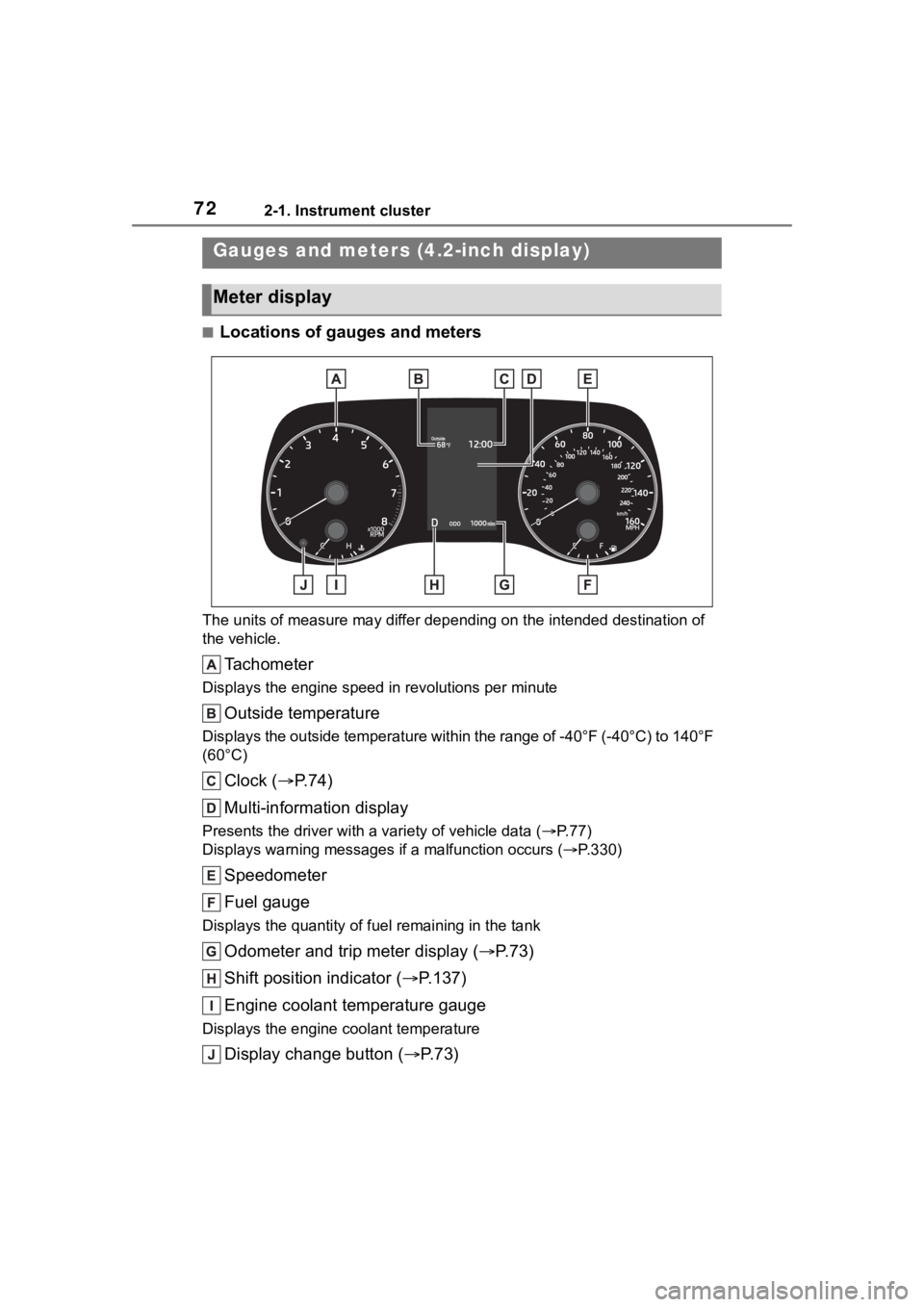
722-1. Instrument cluster
■Locations of gauges and meters
The units of measure may differ depending on the intended destination of
the vehicle.
Tachometer
Displays the engine speed in revolutions per minute
Outside temperature
Displays the outside temperature within the range of -40°F (-40 °C) to 140°F
(60°C)
Clock ( P. 7 4 )
Multi-information display
Presents the driver with a variety of vehicle data (P.77)
Displays warning messages if a malfunction occurs (P.330)
Speedometer
Fuel gauge
Displays the quantity of fu el remaining in the tank
Odometer and trip meter display ( P.73)
Shift position indicator ( P.137)
Engine coolant temperature gauge
Displays the engine c oolant temperature
Display change button ( P.73)
Gauges and meters (4.2-inch display)
Meter display
Page 74 of 436

742-1. Instrument cluster
different distances independently.
To reset, display the desired trip
meter and press and hold the dis-
play change button.
The brightness of the instrument
panel lights can be adjusted.
1Brighter
2 Darker
■Instrument panel light bright-
ness adjustment
When the headlights or parking
lights are turned on, the meter and
instrument panel lights will be
dimmed. However, if the instrument
panel brightness dial is set to the
highest position, the lights will not
dim even if the headlights or parking
lights are turned on.
■The clocks can be adjusted
on the audio system
screen.
Refer to “MULTIMEDIA
OWNER’S MANUAL”.
Changing the instrument
panel light brightness
Adjusting the clock
Page 75 of 436

752-1. Instrument cluster
2
Vehicle status information and indicators
■Locations of gauges and metersEngine coolant temperature gauge
Displays the engine c oolant temperature
Outside temperature
Displays the outside temperature within the range of -40°F (-40 °C) to 140°F
(60°C)
Speedometer/Tachometer
This setting can be changed on the setting screen. ( P.386)
Clock ( P. 7 7 )
Fuel gauge
Displays the quantity of fu el remaining in the tank
Odometer and trip meter display ( P.76)
Shift position indicator ( P.137)
Multi-information display
Presents the driver with a variety of vehicle data (P.83)
Displays warning messages if a malfunction occurs (P.330)
Speedometer
Gauges and meters (7-inch display)
Meter display
Page 77 of 436
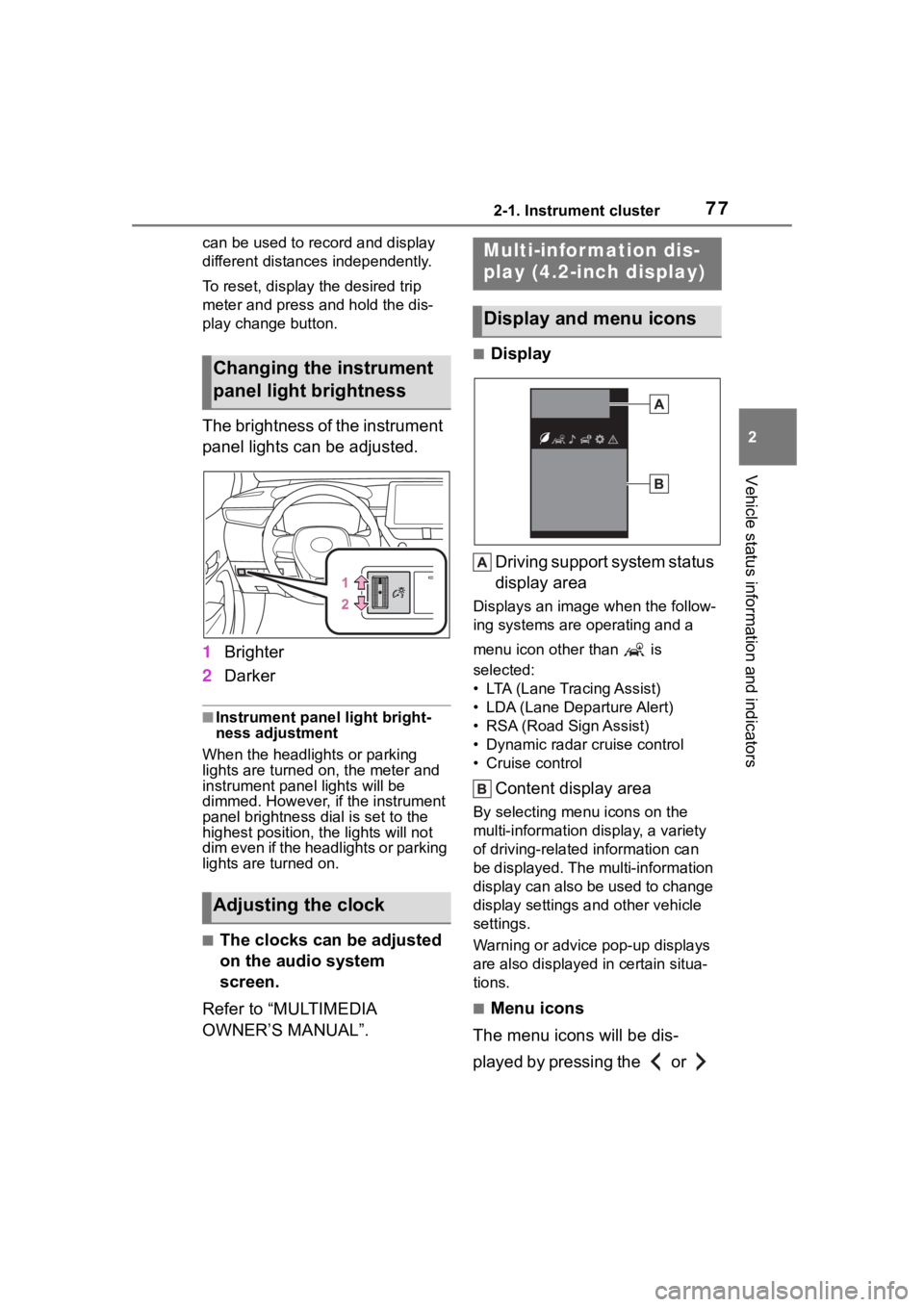
772-1. Instrument cluster
2
Vehicle status information and indicators
can be used to record and display
different distances independently.
To reset, display the desired trip
meter and press and hold the dis-
play change button.
The brightness of the instrument
panel lights can be adjusted.
1Brighter
2 Darker
■Instrument panel light bright-
ness adjustment
When the headlights or parking
lights are turned on, the meter and
instrument panel lights will be
dimmed. However, if the instrument
panel brightness dial is set to the
highest position, the lights will not
dim even if the headlights or parking
lights are turned on.
■The clocks can be adjusted
on the audio system
screen.
Refer to “MULTIMEDIA
OWNER’S MANUAL”.
■Display
Driving support system status
display area
Displays an image when the follow-
ing systems are operating and a
menu icon other than is
selected:
• LTA (Lane Tracing Assist)
• LDA (Lane Departure Alert)
• RSA (Road Sign Assist)
• Dynamic radar cruise control
• Cruise control
Content display area
By selecting menu icons on the
multi-information di splay, a variety
of driving-related information can
be displayed. The multi-information
display can also be used to change
display settings and other vehicle
settings.
Warning or advice pop-up displays
are also displayed in certain situa-
tions.
■Menu icons
The menu icons will be dis-
played by pressing the or
Changing the instrument
panel light brightness
Adjusting the clock
Multi-infor mation dis-
play (4.2-inch display)
Display and menu icons
Page 235 of 436
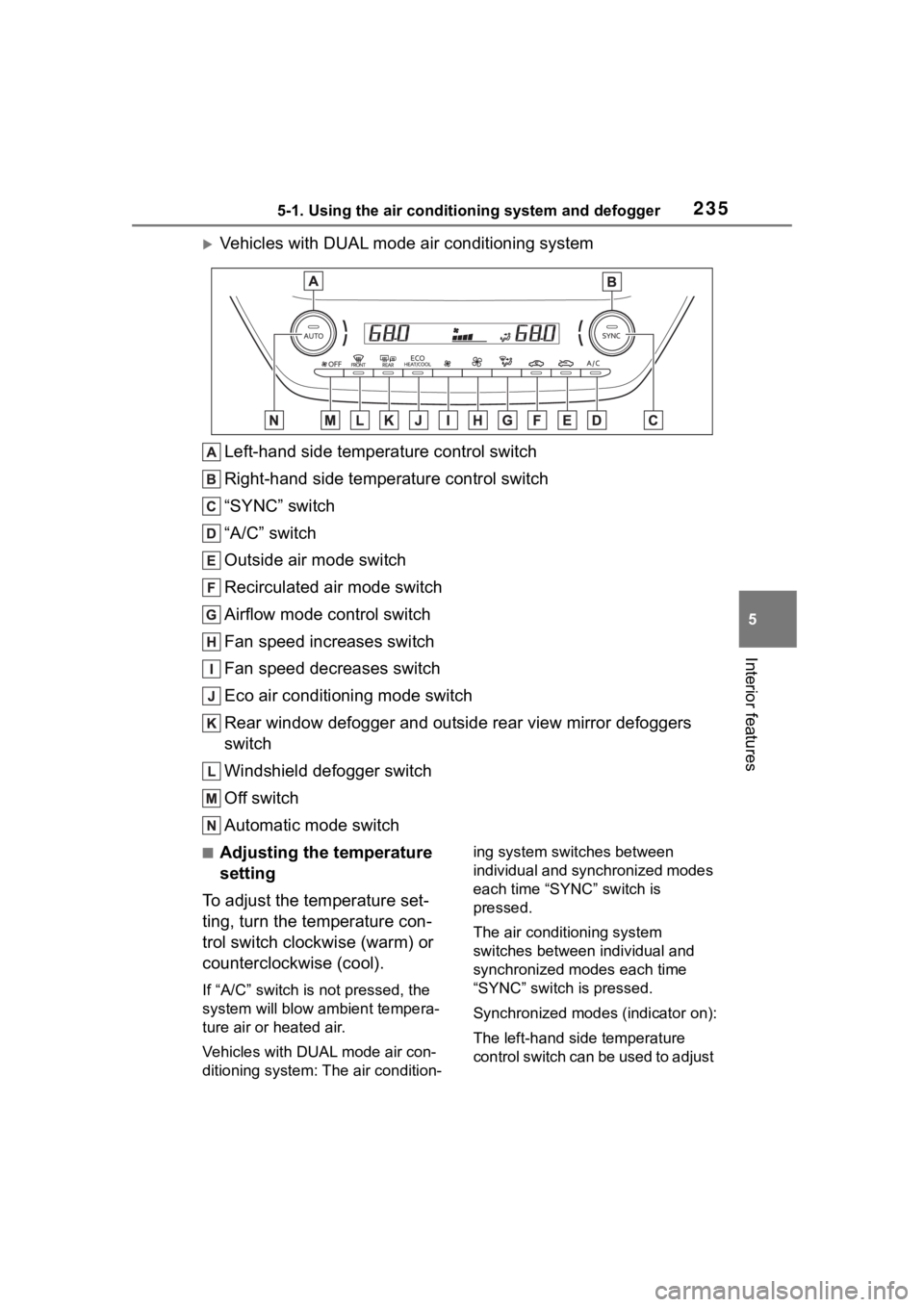
2355-1. Using the air conditioning system and defogger
5
Interior features
Vehicles with DUAL mode air conditioning systemLeft-hand side temperature control switch
Right-hand side temperature control switch
“SYNC” switch
“A/C” switch
Outside air mode switch
Recirculated air mode switch
Airflow mode control switch
Fan speed increases switch
Fan speed decreases switch
Eco air conditioning mode switch
Rear window defogger and outside rear view mirror defoggers
switch
Windshield defogger switch
Off switch
Automatic mode switch
■Adjusting the temperature
setting
To adjust the temperature set-
ting, turn the temperature con-
trol switch clockwise (warm) or
counterclockwise (cool).
If “A/C” switch is not pressed, the
system will blow a mbient tempera-
ture air or heated air.
Vehicles with DUAL mode air con-
ditioning system: The air condition- ing system switches between
individual and synchronized modes
each time “SYNC” switch is
pressed.
The air conditioning system
switches between
individual and
synchronized modes each time
“SYNC” switch is pressed.
Synchronized modes (indicator on):
The left-hand side temperature
control switch can be used to adjust
Page 236 of 436
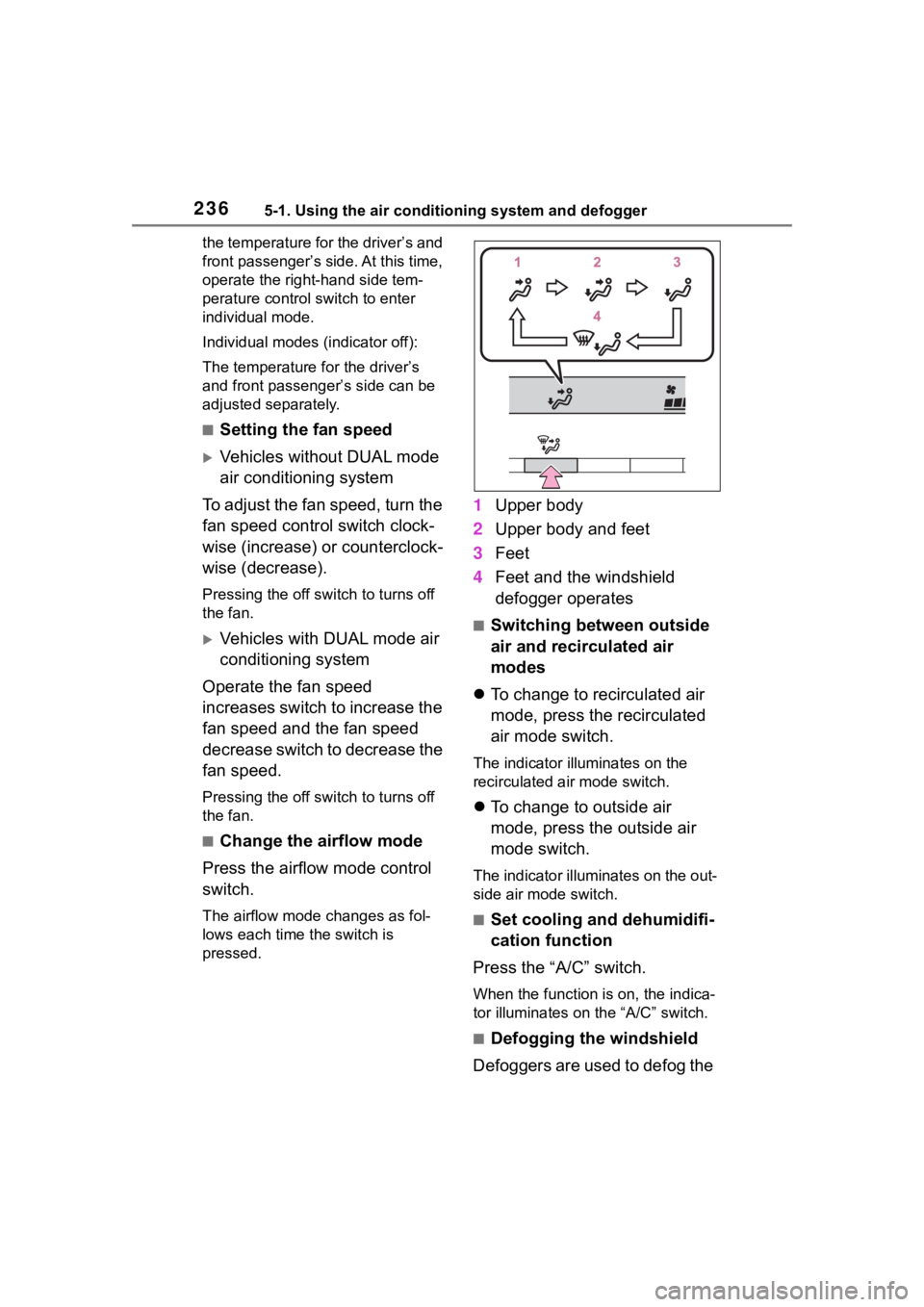
2365-1. Using the air conditioning system and defogger
the temperature for the driver’s and
front passenger’s side. At this time,
operate the right-hand side tem-
perature control switch to enter
individual mode.
Individual modes (indicator off):
The temperature for the driver’s
and front passenger’s side can be
adjusted separately.
■Setting the fan speed
Vehicles without DUAL mode
air conditioning system
To adjust the fan speed, turn the
fan speed control switch clock-
wise (increase) or counterclock-
wise (decrease).
Pressing the off switch to turns off
the fan.
Vehicles with DUAL mode air
conditioning system
Operate the fan speed
increases switch to increase the
fan speed and the fan speed
decrease switch to decrease the
fan speed.
Pressing the off switch to turns off
the fan.
■Change the airflow mode
Press the airflow mode control
switch.
The airflow mode changes as fol-
lows each time the switch is
pressed.
1 Upper body
2 Upper body and feet
3 Feet
4 Feet and the windshield
defogger operates
■Switching between outside
air and recirculated air
modes
To change to recirculated air
mode, press the recirculated
air mode switch.
The indicator illuminates on the
recirculated air mode switch.
To change to outside air
mode, press the outside air
mode switch.
The indicator illuminates on the out-
side air mode switch.
■Set cooling and dehumidifi-
cation function
Press the “A/C” switch.
When the function is on, the indica-
tor illuminates on the “A/C” switch.
■Defogging the windshield
Defoggers are used to defog the
Page 276 of 436

2766-3. Do-it-yourself maintenance
more than 5 minutes for the
oil to drain back into the bot-
tom of the engine.
2 Holding a rag under the end,
pull the dipstick out.
3 Wipe the dipstick clean.
4 Reinsert the dipstick fully.
5 Holding a rag under the end,
pull the dipstick out and
check the oil level.
Low
Normal
Excessive
The shape of the dipstick may differ
depending on the type of vehicle or
engine.
6Wipe the dipstick and reinsert
it fully.
■Checking the oil type and
preparing the item needed
Make sure to check the oil type
and prepare the items needed
before adding oil.
Engine oil selection
P.368
Oil quantity (Low Full)
1.6 qt. (1.5 L, 1.3 Imp. qt.)
Item
Clean funnel
■Adding engine oil
If the oil level is below or near
the low level mark, add engine
oil of the same type as that
already in the engine.
1 Remove the oil filler cap by
turning it counterclockwise.
2 Add engine oil slowly, check-
ing the dipstick.
3 Install the oil filler cap by
turning it clockwise.
■Engine oil consumption
A certain amount of engine oil will
be consumed while driving. In the
following situatio ns, oil consump-
tion may increase, and engine oil
may need to be refilled in between
oil maintenance intervals.
Page 310 of 436
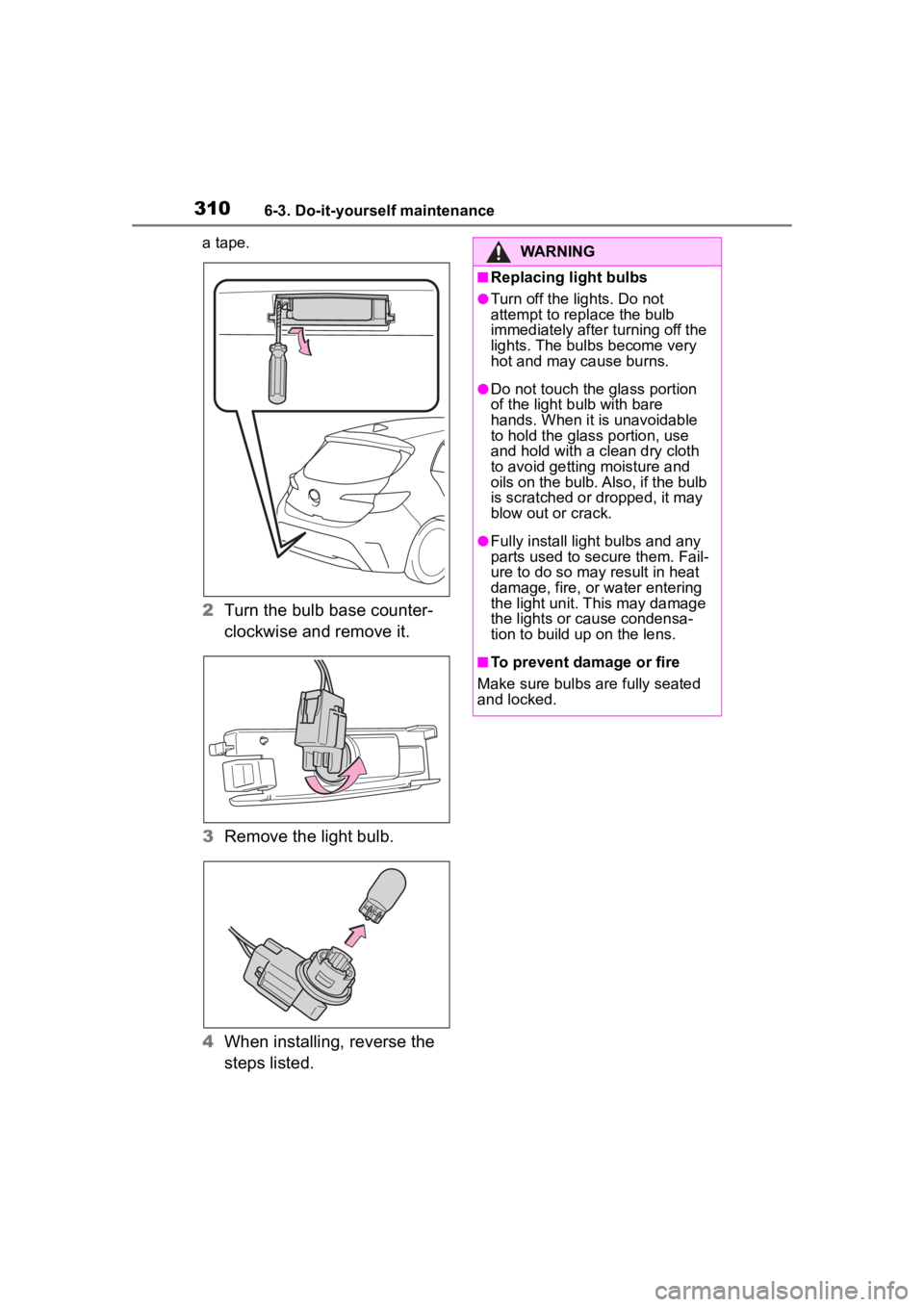
3106-3. Do-it-yourself maintenance
a tape.
2Turn the bulb base counter-
clockwise and remove it.
3 Remove the light bulb.
4 When installing, reverse the
steps listed.
WARNING
■Replacing light bulbs
●Turn off the lights. Do not
attempt to replace the bulb
immediately after turning off the
lights. The bulbs become very
hot and may cause burns.
●Do not touch the glass portion
of the light bulb with bare
hands. When it is unavoidable
to hold the glass portion, use
and hold with a clean dry cloth
to avoid getting moisture and
oils on the bulb. Also, if the bulb
is scratched or dropped, it may
blow out or crack.
●Fully install light bulbs and any
parts used to secure them. Fail-
ure to do so may result in heat
damage, fire, or water entering
the light unit. This may damage
the lights or cause condensa-
tion to build up on the lens.
■To prevent damage or fire
Make sure bulbs are fully seated
and locked.
Page 340 of 436

3407-2. Steps to take in an emergency
place.
7Connect the hose to the
valve.
Screw the end of the hose clock-
wise as far as possible.
8Remove the power plug from
the compressor.
Make sure that the compressor-
switch is off.
9Connect the power plug to
the power outlet socket.
( P.251)
10Attach the sticker provided with the tire puncture repair
kit to a position easily seen
from the driver’s seat.
U.S.A.
Canada
11Check the specified tire infla- tion pressure.
Tire inflation pressure is specified
on the label on the driver’s side pil-
Page 412 of 436
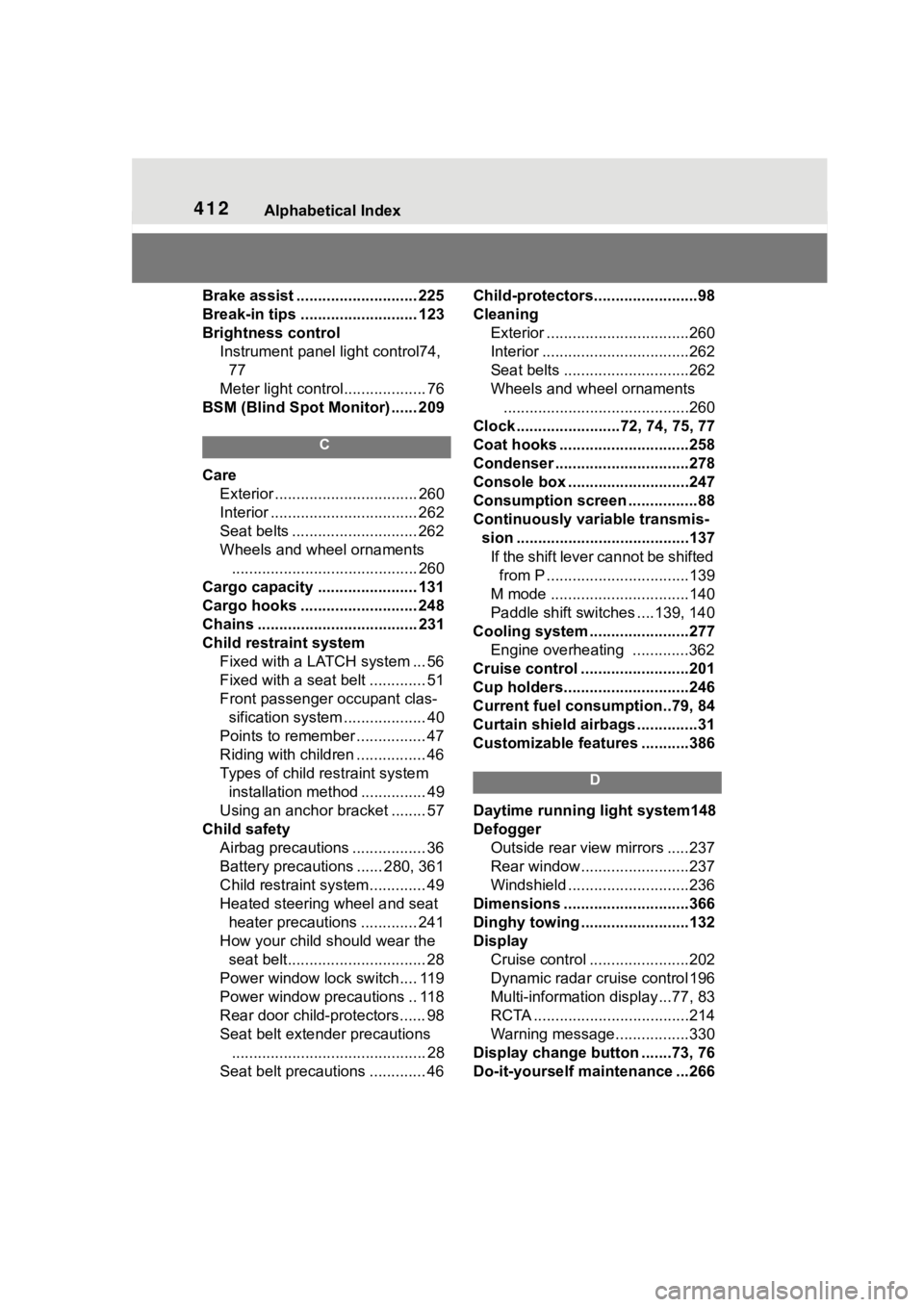
412Alphabetical Index
Brake assist ............................ 225
Break-in tips ........................... 123
Brightness control Instrument panel light control74, 77
Meter light control ................... 76
BSM (Blind Spot Monitor) ...... 209
C
Care Exterior ................................. 260
Interior .................................. 262
Seat belts ............................. 262
Wheels and wheel ornaments........................................... 260
Cargo capacity ....................... 131
Cargo hooks ........................... 248
Chains ..................................... 231
Child restraint system Fixed with a LATCH system ... 56
Fixed with a seat belt ............. 51
Front passenger occupant clas-sification system ................... 40
Points to remember ................ 47
Riding with children ................ 46
Types of child restraint system installation met hod ............... 49
Using an anchor bracket ........ 57
Child safety Airbag precautions ................. 36
Battery precautions ...... 280, 361
Child restraint system............. 49
Heated steering wheel and seat
heater precautions ............. 241
How your child should wear the seat belt................................ 28
Power window lock switch.... 119
Power window precautions .. 118
Rear door child-protectors...... 98
Seat belt extender precautions ............................................. 28
Seat belt precautions ............. 46 Child-protectors........................98
Cleaning
Exterior .................................260
Interior ..................................262
Seat belts .............................262
Wheels and wheel ornaments...........................................260
Clock ................... .....72, 74, 75, 77
Coat hooks ..............................258
Condenser ............. ..................278
Console box ............................247
Consumption screen ................88
Continuously variable transmis- sion ........................................137If th e s hif t le ver ca n no t b e s hif te d from P .................................139
M mode ................................140
Paddle shift switches ....139, 140
Cooling system .......................277 Engine overheating .............362
Cruise control .........................201
Cup holders.............................246
Current fuel consumption..79, 84
Curtain shield airbags ..............31
Customizable featu res ...........386
D
Daytime running light system148
Defogger
Outside rear view mirrors .....237
Rear window.........................237
Windshield ............................236
Dimensions .............................366
Dinghy towing .........................132
Display Cruise control .......................202
Dynamic radar cruise control 196
Multi-information display...77, 83
RCTA ....................................214
Warning message.................330
Display change button .......73, 76
Do-it-yourself maintenance ...266